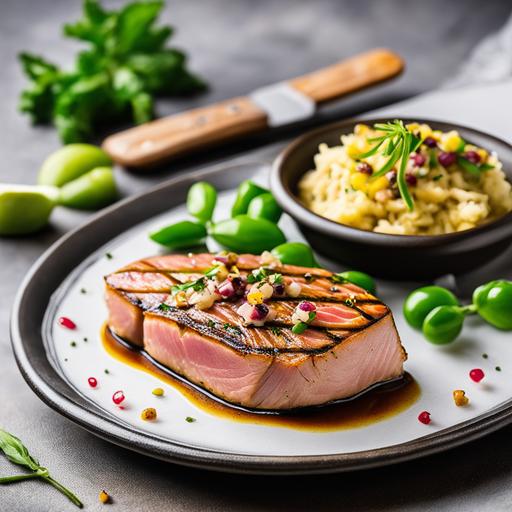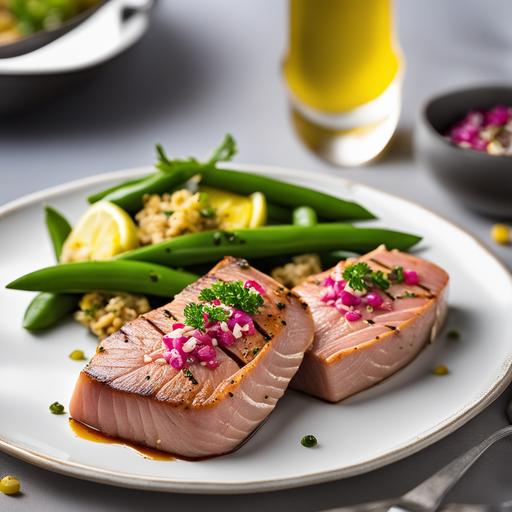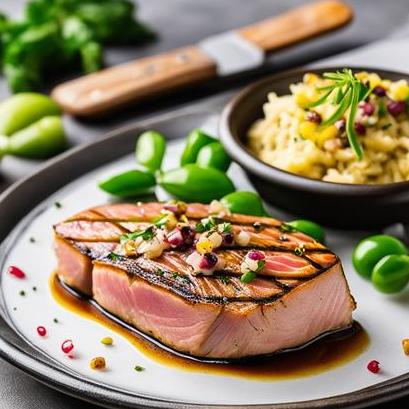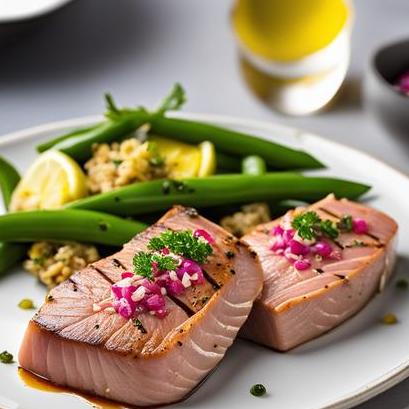
Tuna Steaks Oven Recipe: A Delicious And Healthy Delight
Tuna steaks are a delicious and nutritious option for seafood lovers, offering a meaty texture and rich flavor that pairs well with a variety of seasonings and accompaniments. While tuna is often associated with grilling or pan-searing, cooking tuna steaks in the oven is a convenient and foolproof method that yields perfectly cooked fish every time. In this comprehensive guide, we’ll delve into the food science behind cooking tuna steaks in an oven, explore the factors to consider when choosing ingredients, discuss the importance of preparation techniques, and provide a detailed recipe for preparing tuna steaks in the oven. Whether you’re a seasoned chef or a novice in the kitchen, this article will equip you with the knowledge and skills to create mouthwatering tuna steaks that are sure to impress.
Food Science Of Cooking Tuna Steaks In An Oven
Cooking tuna steaks in an oven involves the principles of dry heat cooking, where the fish is exposed to hot air to promote browning and caramelization while preserving its moisture. Tuna is a dense fish with a relatively low fat content, making it susceptible to drying out if overcooked. However, the oven’s gentle, even heat distribution allows for precise control over the cooking process, ensuring that the tuna remains tender and juicy.
One of the key considerations when cooking tuna steaks in the oven is the Maillard reaction, a chemical process that occurs when proteins and sugars in the fish react at high temperatures, resulting in the formation of complex flavor compounds and characteristic browning. By searing the tuna briefly before transferring it to the oven, you can enhance the depth of flavor and develop a golden crust on the exterior of the fish.
Additionally, the oven’s dry environment helps to concentrate the natural juices of the tuna, intensifying its flavor and preserving its succulence. Unlike methods such as poaching or steaming, which involve cooking fish in liquid, oven-roasting allows for greater caramelization and flavor development, resulting in a more robust and satisfying dish.
Choosing Ingredients
Selecting high-quality ingredients is essential to achieving the best results when cooking tuna steaks in the oven. When purchasing tuna, opt for fresh, sustainably sourced fillets that are firm to the touch and have a vibrant color. Look for tuna steaks that are evenly sized and free from any signs of discoloration or strong odors, as these may indicate deterioration.
In addition to the tuna itself, consider the seasonings and accompaniments that will complement the flavors of the fish. Common ingredients for seasoning tuna steaks include garlic, lemon, herbs such as thyme or rosemary, soy sauce, and spices like black pepper or paprika. Experiment with different flavor combinations to find the perfect balance of seasoning for your taste preferences.
When it comes to choosing side dishes or garnishes, opt for fresh, seasonal ingredients that will enhance the overall meal. Crisp salads, roasted vegetables, or fluffy quinoa make excellent accompaniments to oven-roasted tuna steaks, providing a contrast in texture and flavor that elevates the dish.
Preparing Ingredients

Proper preparation of the ingredients is crucial to ensuring that your tuna steaks turn out tender, flavorful, and perfectly cooked. Start by patting the tuna steaks dry with paper towels to remove any excess moisture, which can prevent proper browning and caramelization during cooking.
Next, season the tuna steaks generously with salt and pepper, ensuring that the seasoning adheres evenly to the surface of the fish. If desired, you can also marinate the tuna steaks in a mixture of olive oil, lemon juice, minced garlic, and herbs for added flavor. Allow the tuna to marinate for at least 30 minutes to allow the flavors to penetrate the fish.
While the tuna is marinating, preheat your oven to the optimal cooking temperature. For tuna steaks, a temperature of 400°F (200°C) is ideal, as it allows for efficient browning and caramelization without overcooking the fish. Preheating the oven ensures that it reaches the desired temperature before you add the tuna steaks, promoting even cooking and consistent results.
Optimal Oven Cooking Temperature & Timing
The optimal cooking temperature and timing are critical factors in achieving perfectly cooked tuna steaks in the oven. As mentioned earlier, a temperature of 400°F (200°C) is recommended for oven-roasting tuna steaks, as it promotes caramelization and flavor development while preserving the fish’s moisture.
When cooking tuna steaks in the oven, the cooking time will vary depending on the thickness of the fillets and your desired level of doneness. As a general rule of thumb, aim to cook the tuna for 10-12 minutes per inch of thickness, flipping halfway through the cooking time to ensure even browning on both sides.
To test for doneness, use a meat thermometer to measure the internal temperature of the tuna steaks. For medium-rare tuna, the internal temperature should reach 125°F (52°C), while medium tuna should register 135°F (57°C). Remember that the tuna will continue to cook slightly after it is removed from the oven, so it’s essential to factor in residual heat when determining the cooking time.
Tuna Steaks Oven Recipe
Ingredients
- 4 tuna steaks (6 ounces each)
- 2 tablespoons olive oil
- 2 cloves garlic, minced
- 1 teaspoon lemon zest
- 1 tablespoon lemon juice
- 1 teaspoon dried thyme
- Salt and pepper, to taste
Instructions
- Preheat your oven to 400°F (200°C) and line a baking sheet with parchment paper or aluminum foil.
- In a small bowl, whisk together the olive oil, minced garlic, lemon zest, lemon juice, dried thyme, salt, and pepper to create the marinade.
- Pat the tuna steaks dry with paper towels and season them generously with salt and pepper on both sides.
- Place the seasoned tuna steaks in a shallow dish and pour the marinade over them, ensuring that they are evenly coated. Cover the dish with plastic wrap and refrigerate for at least 30 minutes to allow the flavors to meld.
- Once the tuna has marinated, remove it from the refrigerator and let it come to room temperature for 10-15 minutes.
- Transfer the tuna steaks to the prepared baking sheet, leaving space between each fillet to promote even cooking.
- Roast the tuna steaks in the preheated oven for 6-8 minutes, depending on the thickness of the fillets, flipping halfway through the cooking time to ensure even browning.
- Remove the tuna steaks from the oven and transfer them to a serving platter. Allow the fish to rest for a few minutes before serving to allow the juices to redistribute.
- Garnish the tuna steaks with fresh herbs, lemon wedges, or a drizzle of olive oil, if desired. Serve immediately with your favorite side dishes or accompaniments.
Cooking tuna steaks in the oven is a simple yet elegant way to prepare this versatile seafood dish. By understanding the principles of dry heat cooking and following a few key steps, you can achieve perfectly cooked tuna steaks that are tender, flavorful, and bursting with natural juices. Whether you’re hosting a dinner party or preparing a weeknight meal for your family, this oven-roasted tuna steak recipe is sure to become a favorite in your culinary repertoire. Experiment with different seasonings and side dishes to create a personalized twist on this classic dish, and enjoy the delicious flavors of fresh, oven-roasted tuna steaks.
Doneness Checks

Cooking tuna steaks in the oven offers a convenient and efficient method to attain succulent, evenly cooked fish without the need for constant monitoring. Unlike grilling or pan-searing, oven baking provides consistent heat distribution, ensuring that the tuna cooks evenly throughout. Additionally, oven baking allows for the incorporation of various flavors and seasonings, resulting in a customizable culinary experience.
Before delving into the cooking process, it’s essential to select high-quality tuna steaks. Opt for fresh or frozen tuna steaks from reputable sources to ensure optimal taste and texture. Fresh tuna steaks should have a vibrant color, firm texture, and a mild, briny aroma, while frozen steaks should be solidly frozen without any signs of freezer burn.
Achieving the perfect level of doneness is crucial when cooking tuna steaks to ensure a tender, moist interior while maintaining a seared, flavorful exterior. Here are some key indicators to determine the doneness of tuna steaks:
1. Color
- Rare: A rare tuna steak will have a vibrant red or pink center with slight translucency. The exterior should be lightly seared.
- Medium-Rare: Medium-rare tuna will display a slightly less vibrant red color in the center with a larger portion of opaque flesh surrounding it.
- Medium: A medium tuna steak will have a pink center with minimal translucency and a more substantial portion of opaque flesh.
- Well-Done: Well-done tuna will have a fully opaque, light pink center with little to no translucency.
2. Texture
- Rare to Medium-Rare: Tuna cooked to these levels of doneness will have a tender, almost buttery texture.
- Medium to Well-Done: Tuna cooked to medium or well-done will have a firmer texture, resembling that of cooked steak.
3. Temperature
- Rare: 110°F to 120°F (43°C to 49°C)
- Medium-Rare: 125°F to 130°F (52°C to 54°C)
- Medium: 135°F to 140°F (57°C to 60°C)
- Well-Done: 145°F (63°C) or higher
To accurately gauge the internal temperature of the tuna steak, use a meat thermometer inserted into the thickest part of the fish.
Undercooking
Undercooking tuna steaks can result in a fishy taste and unpleasant texture, leaving the interior raw and cold. To avoid undercooking, ensure that the oven is preheated to the recommended temperature before placing the tuna steaks inside. Additionally, adhere to the suggested cooking times based on the thickness of the steaks to ensure thorough cooking.
If you find that your tuna steaks are undercooked, return them to the oven and continue cooking in increments of 1-2 minutes until the desired doneness is achieved. Keep a close eye on the steaks to prevent overcooking while allowing them to reach the desired temperature.
Overcooking
Overcooking tuna steaks can result in dry, tough flesh, detracting from the natural flavors of the fish. To prevent overcooking, avoid leaving the tuna steaks in the oven for longer than the recommended cooking time. It’s crucial to monitor the internal temperature of the steaks closely to prevent them from surpassing the desired level of doneness.
If you accidentally overcook your tuna steaks, consider serving them with a flavorful sauce or accompaniment to enhance their moisture and flavor. Alternatively, chop the overcooked tuna and incorporate it into salads or sandwiches, where the texture is less noticeable.
Troubleshooting

Encountering issues while cooking tuna steaks in the oven is not uncommon, but with the right techniques, most problems can be resolved. Here are some common troubleshooting tips:
1. Dry Tuna
- Cause: Overcooking or using low-fat tuna cuts can result in dryness.
- Solution: Baste the tuna steaks with olive oil or butter before cooking to add moisture. Additionally, consider marinating the tuna in a flavorful liquid to enhance its juiciness.
2. Uneven Cooking
- Cause: Variations in the thickness of the tuna steaks can lead to uneven cooking.
- Solution: Use a meat mallet to gently pound the thicker portions of the tuna steaks to ensure uniform thickness. Alternatively, fold thinner sections of the steak under to create a more consistent shape.
3. Fishy Taste
- Cause: Low-quality or improperly stored tuna steaks can develop a strong fishy taste.
- Solution: Purchase fresh or high-quality frozen tuna steaks from reputable sources. Properly store the tuna in the refrigerator or freezer to maintain its freshness and flavor.
Recipe Variations
Experimenting with different flavors and ingredients can elevate the taste of oven-baked tuna steaks. Here are some tantalizing recipe variations to try:
1. Asian-Inspired Glaze
- Ingredients: Soy sauce, ginger, garlic, honey, sesame oil.
- Method: Whisk together the ingredients to create a marinade, then brush it onto the tuna steaks before baking. Garnish with sesame seeds and green onions before serving.
2. Mediterranean Herb Crust
- Ingredients: Fresh herbs (such as rosemary, thyme, and oregano), garlic, lemon zest, breadcrumbs, olive oil.
- Method: Mix the chopped herbs, garlic, lemon zest, and breadcrumbs with olive oil to form a paste. Press the mixture onto the top of the tuna steaks before baking for a flavorful crust.
3. Cajun Spice Rub
- Ingredients: Paprika, cayenne pepper, garlic powder, onion powder, thyme, oregano, salt, pepper.
- Method: Combine the spices to create a Cajun seasoning blend, then rub it onto the tuna steaks before baking. Serve with a side of creamy coleslaw for a delicious contrast.
Cooking tuna steaks in the oven offers a convenient and foolproof method to achieve tender, flavorful fish with minimal effort. By following the guidelines outlined in this article, you can confidently prepare oven-baked tuna steaks that are perfectly cooked every time. Experiment with different flavors and seasonings to customize your dish and delight your taste buds with each succulent bite. Whether you prefer a rare delicacy or a well-done masterpiece, oven-baked tuna steaks are sure to satisfy your seafood cravings.
Flavour Enhancement Tips
Tuna steaks, cut from the loin of the fish, boast a firm texture and rich taste that make them ideal for various cooking methods, including grilling, pan-searing, and broiling. However, baking tuna steaks in the oven presents a convenient and fuss-free alternative, particularly for those seeking a hands-off approach to cooking. By leveraging the oven’s steady heat distribution, you can achieve evenly cooked tuna steaks with a delightful sear on the outside and tender, moist flesh within.
Enhancing the flavor of tuna steaks is crucial for elevating the dining experience and satisfying the taste buds. Consider implementing the following flavor enhancement tips:
Marinades
Marinating tuna steaks before baking can infuse them with layers of flavor and tenderize the meat. Opt for marinades featuring ingredients like soy sauce, citrus juices (such as lemon or lime), garlic, ginger, honey, and herbs (such as thyme or cilantro). Allow the tuna steaks to marinate for at least 30 minutes, or ideally, refrigerate them overnight for maximum flavor penetration.
Spice Rubs
For a bolder flavor profile, coat tuna steaks with a dry spice rub before baking. Common spices and herbs for tuna include paprika, cumin, coriander, chili powder, black pepper, and dried oregano. Adjust the spice blend according to your taste preferences, ensuring a well-balanced combination of heat, earthiness, and aromatic notes.
Aromatics
Incorporate aromatic ingredients such as minced garlic, shallots, onions, and fresh herbs into your tuna steak preparations. These aromatic elements add depth and complexity to the flavor profile, complementing the natural richness of the fish.
Texture Enhancement Tips

Achieving the ideal texture is paramount when baking tuna steaks in the oven. Follow these tips to ensure tender, succulent results:
Proper Searing
Before transferring the tuna steaks to the oven, sear them in a hot skillet or grill pan for 1-2 minutes per side. Searing locks in moisture and creates a flavorful crust on the exterior of the steaks, enhancing both texture and taste.
Temperature Control
To prevent overcooking and maintain the tuna steaks’ moistness, aim for an internal temperature of 125-130°F (52-54°C) for medium-rare or 135-140°F (57-60°C) for medium doneness. Use a reliable meat thermometer to monitor the internal temperature and avoid the risk of dry, tough tuna steaks.
Resting Period
Allow the tuna steaks to rest for a few minutes after baking to allow the juices to redistribute evenly throughout the meat. Resting also helps ensure a more tender and juicy texture, as the residual heat continues to cook the steaks slightly while they rest.
Cooking At Different Temperatures
Baking tuna steaks in the oven offers flexibility in terms of temperature settings, allowing you to tailor the cooking process to your preferences. Here’s how to adjust the oven temperature for different outcomes:
High Temperature (400-450°F / 204-232°C)
Baking tuna steaks at a high temperature results in a quick cooking process, yielding a beautifully seared exterior and a slightly rare to medium-rare interior. This method is ideal for those who prefer their tuna steaks with a more pronounced crust and a tender, pink center.
Moderate Temperature (350-375°F / 177-190°C)
Cooking tuna steaks at a moderate temperature allows for more gradual cooking, producing a uniformly cooked interior with a gentle sear on the outside. This temperature range is suitable for individuals seeking a balance between a well-seared exterior and a fully cooked, but still moist, interior.
Low Temperature (300-325°F / 149-163°C)
Baking tuna steaks at a low temperature results in a slower cooking process, ideal for those who prefer their fish to be cooked through evenly without the risk of drying out. While this method may not produce a pronounced sear, it yields exceptionally tender and moist tuna steaks with a consistent texture throughout.
Cooking Tips
Mastering the art of baking tuna steaks in the oven requires attention to detail and precision. Follow these cooking tips for optimal results:
Preheating The Oven
Ensure that your oven is fully preheated to the desired temperature before placing the tuna steaks inside. Preheating allows for consistent heat distribution and promotes even cooking throughout the baking process.
Using A Baking Dish Or Sheet Pan
Arrange the tuna steaks on a lightly greased baking dish or sheet pan, ensuring that they are spaced apart to allow for adequate air circulation. Avoid overcrowding the pan, as this can impede the searing process and result in uneven cooking.
Monitoring Cooking Time
Keep a close eye on the tuna steaks as they bake, as the cooking time can vary depending on the thickness of the steaks and the oven temperature. Aim to achieve the desired level of doneness without overcooking, as tuna can become dry and tough if cooked for too long.
Testing For Doneness
Use a meat thermometer to check the internal temperature of the tuna steaks, inserting it into the thickest part of the fish. Remember to account for carryover cooking during the resting period, as the internal temperature will continue to rise slightly after the steaks are removed from the oven.
Serving Suggestions
Once your tuna steaks are perfectly baked and infused with flavor, it’s time to plate them up and enjoy! Here are some serving suggestions to complement your oven-baked tuna steaks:
Accompaniments
Serve the tuna steaks alongside a variety of accompaniments, such as roasted vegetables, steamed rice, quinoa salad, or mashed potatoes. The sides can be customized to suit your preferences and enhance the overall dining experience.
Sauces And Condiments
Enhance the flavor of the tuna steaks with a drizzle of sauce or a dollop of condiment. Consider options such as teriyaki glaze, citrus vinaigrette, wasabi mayo, or salsa verde to add a burst of flavor and freshness to the dish.
Garnishes
Add visual appeal and an extra layer of flavor to your tuna steaks with thoughtful garnishes. Sprinkle chopped fresh herbs, such as parsley, cilantro, or chives, over the steaks for a pop of color and herbaceous aroma. Alternatively, garnish with sesame seeds, toasted almonds, or crispy fried shallots for added texture and crunch.
Conclusion
Baking tuna steaks in the oven offers a convenient and hassle-free method for preparing flavorful and tender seafood dishes. By incorporating marinades, spice rubs, and aromatic ingredients, you can enhance the flavor profile of the tuna steaks and delight your taste buds with each bite. Paying attention to proper searing, temperature control, and resting periods ensures that the tuna steaks are cooked to perfection, with a succulent texture and mouthwatering taste. Whether served alongside roasted vegetables, steamed rice, or a vibrant salad, oven-baked tuna steaks are sure to impress diners and elevate any mealtime experience. So, roll up your sleeves, preheat your oven, and embark on a culinary adventure with tantalizing tuna steaks as your guide. Bon appétit!
FAQS
What Is The Best Way To Prepare Tuna Steaks In The Oven?
To get the most flavor and tenderness, it is recommended to marinate the tuna steaks for at least 30 minutes before cooking. Also, make sure to preheat the oven to a high temperature (typically around 425°F) before placing the steaks in the oven.
How Long Should I Cook Tuna Steaks In The Oven?
The cooking time for tuna steaks in the oven will depend on the thickness of the steaks and your desired level of doneness. As a general rule, it is recommended to cook the steaks for 10-12 minutes for medium rare, 12-14 minutes for medium, and 14-18 minutes for well done.
Can I Use Frozen Tuna Steaks For This Recipe?
Yes, you can use frozen tuna steaks for this recipe. However, make sure to fully thaw the steaks before cooking to ensure even cooking and a more flavorful end result.
What Are Some Good Marinade Options For Tuna Steaks?
Some popular marinade options for tuna steaks include soy sauce, lemon juice, olive oil, garlic, and herbs. You can also try using a teriyaki or honey-glazed marinade for a sweeter flavor.
How Do I Know When Tuna Steaks Are Done Cooking?
A good way to check if the tuna steaks are done cooking is to use a meat thermometer. The internal temperature should reach 145°F for medium rare, 160°F for medium, and 175°F for well done. You can also visually check the color of the tuna – it should be opaque and flaky when cut with a fork.


